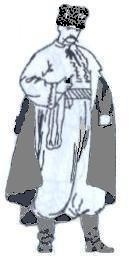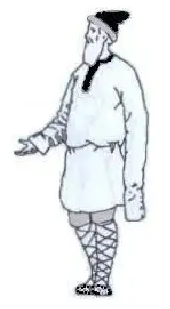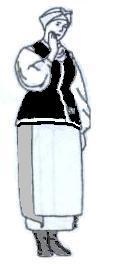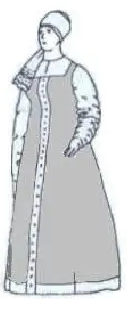Prerequisites of Rise of Ethnic Differences between Ukrainians and Russians
Ukrainians and Russians, like all Slavs in general, are a large family of Indo-European peoples, which originated in ancient times. First, all Indo-Europeans had a common language and belonged to the same anthropological type, but eventually, settling in a wide expanse of Europe and Asia, they are divided into separate tribes, of which gradually formed the primary ethnic groups who have gone different ways of development, but remained features of common origin in their languages. Later, the newly formed division of ethnic groups occurred more than once, and rather by difficult ways a lot of ancient and modern European nations were formed.
Slavs stood out from the Indo-European community, together with other primary ethnic groups, among whom were the Indo-Aryans, the Iranians, Greeks, Italics, Germans, Armenians, Balts, Thracians, and others, but longer than the others remained in their homeland. Therefore Slavs preserved in their languages much more in common than, say, the Germanic peoples who were divided into separate tribes long before the Slavs. At the end of the first millennium BC. Slavs begin their expansion in different directions and occupy the territory from the Vistula River in the west to the east of the Oka, on the Western Dvina in the north, and to the border of forest in the south. For a time after the settlement, Slavs still retained a common language and common anthropological features, but at the beginning of a new era, they already spoke different dialects and mixed with various indigenous populations began to acquire various anthropological traits. The division between western and eastern Slavs became expressive because the border between them was the Dnieper River. The western branch of the Slavic ancestors included modern Ukrainians, Belarusians, Poles, Slovaks, Czechs, and other ethnic groups, descendants or completely assimilated with other nations, or were in small quantities, for example, the Sorbs in Germany. The eastern branch of the Slavs was presented by the ancestors of the Bulgarians, Serbs, Croats, Slovenes, Macedonians, and part of modern Russian [STETSYUK VALENTYN. 2000: 36-48]. Thus, figuratively speaking, Ukrainians and Russians, born Slavs, had different childhoods, which predetermined their future history, if we agree with the words of one of the representatives of the new historical school [LE GOFF JACQUES. 2005. 2005: 137].

The difference between the Western and Eastern Slavs manifested in language and culture. The western Slavs settled the territory populated long before by the Germanic tribes which mostly migrated to the West, even though a small portion remained on the old place settlement. Just-arrived Slavs mixed with the remnants of the Germans, borrowed some words, especially those that are meant for them new concepts and subjects. But with the development of culture, new words were formed in their midst on their own linguistic basis.

The Eastern Slavs inhabited mainly the lands on which the tribes of the Finno-Ugric and the Baltic peoples dwelled lived. The area between the Dnieper and the Volga River was outside the influences that came northeast from the cultural centers of the Middle Sea, and therefore the population of this territory was somewhat inferior in development to the inhabitants of the basin of the right tributaries of the Dnieper River. This is also noted in the language of the Eastern Slavs – there were fewer neologisms in their dialects than in the dialects of their Western relatives. And there were significantly fewer loan words of Germanic or Latin origin that were being brought into the language of the Eastern Slavs through the language of the Western.
And at the same time, one fundamental discrepancy appeared in the languages of Ukrainians and Russians, which at first glance seems insignificant, but in fact, it forms a great deal of the psychology of people. This refers to the difference in the statement of the fact of a person possessing something – an object, property, duty, quality, etc. When Ukrainians say "I have, you had, we had…", then Russians use a completely different verbal construction: "it is to me, this is to you, that is to us…". Both constructions are based on two different verbs – "to have" for Ukrainians and "to be" for Russians. The construction on the base “to be” is considered the primary. At different times almost all the peoples of Europe replaced the construction with the basis of "to have". The Russians are one of the few nations that have retained an archaic form, and this has greatly influenced their psychology. The prominent German psychoanalyst Erich Fromm wrote that "empirical anthropological and psychoanalytic data tend to demonstrate that having and being are two fundamental modes of experience, the respective strengths of which determine the differences between the characters of individuals and various types of social character" [FRROMM ERICH. 1986: 27-28]. We do not undertake to determine how different language constructions caused differences between the characters of Ukrainian and Russian, but just take this fact into account.
Since the middle of the first millennium A.D. Slavs begin a new expansion in Central Europe and the Balkans. In the old places of settlements or near them only the ancestors of modern Ukrainians, Belarusians, and Russians remain, and their proximity resulted in the appearance of some new common features in their languages that distinguish them from the languages of modern Western and Southern Slavs. However, Ukrainians and Belarusians continued to have closer contact with the Poles than with the Russians due to the lack of special geographical obstacles between the territories of the settlements of these three peoples. The contacts of the Ukrainians and Belarusians with the Russians were largely hindered by the wide course of the Dnieper. Thus, the Ukrainians and Belarusians perceived the influence of European civilization through the Poles much more than the Russians.
The American scientist Warren Hollister, defining the concept of civilization, names three of its signs – the presence of cities, metalworking, and literature [HOLLISTER C. WARREN. 1991:11]. Of these, the main is the presence of cities as centers for the development of culture and crafts. It follows that building terminology in the language of the people can be a sign of belonging to a particular civilization. Examining from this angle the differences between Ukrainians and Russians, we can compare their building terminology and try to draw some conclusions. This comparison convinces us that Ukrainians and Russians have completely different words for building structures, parts, and materials, except for the simplest ones, such as a window, door, threshold, and stove. For example, the gate is named by Russians vorota but Ukranians name it sometimes brama, roof is named by Ukrainians dakh but Russians do it krysha, porch – Ukr. ganok and Rus. kryltso, chimney – Ukr. komyn and Rus truba, floor – Ukr pidloha and Rus. pol, rafter – Ukr. krokva and Rus. stropilo, scaffolding – Ukr. ryshtuvannia and Rus. "lesa", ladder – Ukr. drabyna and Rus. lestnitsa, chalk – Ukr. kreida und Rus. mel, lime – Ukr vapno and Rus. "izvest'" etc.


During the time of Kievan Rus, contacts between Ukrainians, Russians, and Belarusians revived, with the adoption of Christianity, culture began to develop under the influence of the Byzantine, but since the routes of communication were not well developed, the contacts were not close, so the differences between the languages of these peoples only increased, although this time a certain group of common words appeared: dog – sobaka, squirrel – belka, forty sorok, ninety devianosto and some others. After the collapse of Kievan Rus, contacts between Ukrainians and Russians almost ceased, and contacts between Ukrainians with residents of Central Europe became closer.
These contacts were especially livened up from the time of King Daniel, who began to invite German artisans to the Galicia-Volyn state. In the cities, the construction of stone houses instead of wooden ones, as well as the paving of streets, and the construction of city walls, begins. Since the builders were often German masters, a new group of words entered the Ukrainian language, which is of German origin or came through German mediation from other European languages: blakha, brukivka, gruba, ganok, gzimsi, gont, kimnata, komin , likhtar, lyada, liokh, rinva, tinc, cegla , shlakh, etc. Also, thanks to German artisans, many German words of craft terminology entered the Ukrainian language: galmo (brake), hartuvati (to temper), gabli (fork) , gambel (planer), gvynt (screw), graty (lattice), drit (wire), karbuvati (to mint), lanceg (chain), rykhtuvaty (edit, make fit) , shtaba (strip of metal), shrub (screw), tsvyakh (nail) and other lesser known ones. The word meister itself, as well as verstat, and the names of some types of craft are also of German origin, cf. brovar (brewer), limar (sadler), kushnir ( furrier), slyusar, snitsar (locksmith), stelmach (carriage i>), tesler (carpenter). There are also enough borrowings from German or other European languages in the cultural and social spheres: – arkush (sheet of paper ), bavovna (cotton), bandura, galba (half-liter glass), gaptuvati (embroider), gvalt (violence), drukuvati (print), zhart (joke), kahli (tiles), kleinodi (jewelry), kshtalt (image, likeness), litera (letter), painting (draw), music , papir (paper), penzel (brush), farba (paint), fakh ( profession), funduvati (donate, found), tricky (fur), tsikha (feature), tsukor (sugar), shinok (tavern), shtuka (art). From military terminology, one can find such foreign words asgarmata, hetman, kulya, musket, list. It should be noted that almost all the words given here are absent in Russian, with the exception of the words screw, room, music, mechanic and possibly some others that got into the Russian language through Ukrainian or through Polish.
The monetary system, administration, and law can also be a sign of belonging to a particular civilization. Ukrainian words borg (debt), viyt (headman), gmina (administrative district), groshi (money) , magistrate, penyaz, town hall, market, soltis (headman), talyar (monetary unit), filvarok (manor's estate, farmstead), chinsh (tax in kind or cash), shelyag (small monetary unit) – all these are traces of European civilizational influences of different times. But these influences became especially expressive at the beginning of the 14th century when Ukrainian cities acquired the Magdeburg Law, which had previously been codified on the customary German law in the city of Magdeburg. The city of Volodymyr was the first to receive this right (earlier in 1324), followed by Syanok, Lviv, and Kamenets. Gradually, many Ukrainian cities received this right, among which were Kyiv, Chernihiv, Pereyaslav, Poltava and many others. And even after the annexation of Ukraine to Russia, they continued to use it, until in 1831 and 1835 it was abolished by royal decrees. Around the same time, the Lithuanian statute in the edition of 1585, which was developed using the principles of Roman law, was in force in Ukraine.
In general, European culture did not reach Muscovy for a long time, which for a long time was in the spheres of influence of Asian and Byzantine cultures. There are a lot of borrowings into the Russian language from Turkic and Persian, and most of them are absent in the Ukrainian language. We can cite some of them as an example. From the construction terminology, which is important for us as a sign of civilization, there are not very many examples, since the main borrowings into the Russian language have been made since the time of Peter I from European languages. However, the Turkic or Persian origin is Rus. ambar "barn", balagan "booth", kalancha "tower", kirpich "brick", saray "barn", barn, ochag "furnace", shalash "hut", Greek – izvest' "lime". The abundance of borrowings into Russian from Eastern languages for the names of clothing and footwear is striking. armyak, balakhon, bashlyk, basshmak, epancha, zipun, kabluk, karman, caftan, kushak, malachai, sarafan, sapog, chulok, etc. There are also many borrowings in the trade and financial sector: almaz, altyn , arshin, bakalea, barysh, batman, bash na bash, biaz', dengi, izium, kazna, kiset, kumach, runduk, sunduk, tamozhnia, xhemodan, yarlyk . From borrowings in a purely cultural sphere, one can cite as examples the name (bumaga and karandash), musical instrument balalaika, dice alchik. All these examples show that for a long period of time Muscovy, despite the Byzantine Christian tradition, was under the cultural influence of Asian countries. The Ukrainian language also has many borrowings from the Turkic languages, but their influence was not significant on the general cultural development of Ukrainians, although it should be recalled that the Ukrainian kobza and surma are of Turkic origin.
Thus, at the time when the foundations of the national character were being laid, Ukrainians and Russians belonged to completely different civilizations. True, they had a common faith, which formally kept Ukraine in the sphere of Byzantine culture, but contacts between churches were very weak, and after Ukraine joined Russia, it turned out that the differences in the liturgical rites of both Orthodox churches were so striking that the Moscow Church was influenced by Ukrainian priests had to go for church reform, which caused a well-known schism. Ukrainian cultural influences on Russia at the end of the 17th and in the first half of the 18th century are known to specialists and there is a lot of literature devoted to them, so there is no need to dwell on them. However, in Ukrainian society, even among educated people and, what is especially sad, among politicians, there is an opinion about the ethnic and cultural unity of Ukrainians and Russians. The existence of such an opinion has always been of interest not only to the ruling elite in Russia but also to some extent to the Russian scientific and cultural elite. This idea was imposed on Ukrainians for three centuries, and not without success, especially since the long-term existence of Ukrainians and Russians in one state could not but affect the rapprochement of their national characters and cultures. However, the difference between the representatives of both peoples is visible to the naked eye, although scientific research in this direction has not really been carried out.

